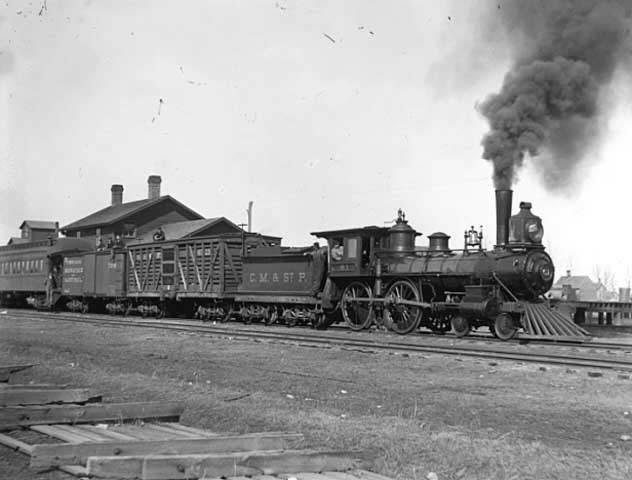
Traveling by Train

The growth of the railroads through the western United States was key in helping to populate the Midwestern states like Minnesota, Wisconsin, Iowa and Nebraska. By 1868 the railroads had begun to spread their network over the State of Minnesota. Railroad companies and shipping lines worked together, and so it was possible for an emigrant to buy a ticket directly from a town in Europe to arrive in Avoca, Red Wing, or another of the rail stations in Minnesota.
In the 1870's the Northern Pacific Railway Company advertised the Minnesota region through thousands of leaflets distributed by agents in southwestern and northeastern Germany. The Minnesota Catholic Immigration Bureau also circulated flyers to the populations in Europe. In St. Paul, Minnesota, Bishop Ireland arranged with St. Paul and the Pacific Railroad, later the St. Paul, Minneapolis, and Manitoba, (1878) to secure large tracts of land in western Minnesota where Catholics might settle in communities or "colonies." By 1880 the census showed a population which had grown to 780,773, of which 71 percent were Europeans of the first and second generations. The Germans came in the greatest numbers, then the Irish, and then Canadians from beyond the border. The Fritscher family and their friends were counted in these numbers. They traveled by boat and by rail, seeking out the rich farmland where they could settle and practice their religion near others from their homeland.
For the journey to Minnesota, immigrants were advised to take the railroad from New York to Buffalo and then take a boat across the great lakes to Milwaukee, Wisconsin. From Milwaukee they were to take the railroad to La Crosse, Wisconsin, and get on a steamboat to head up the river to Winona or St. Paul, Minnesota. Although we cannot be sure, it is possible that the Fritscher family made the trip to Minnesota in this way.
The Colony village of Avoca was situated on a charming lake, twenty miles from Heron Lake, a station on the line of the St. Paul and Sioux City Railroad. Directly through this section was built the Southern Minnesota Railroad, which brought the colonists in direct communication with the Chicago and Milwaukee markets. There were three other Colony villages including Adrian. The Fritschers and their extended families had as their destination one of these Colony villages, and eventually they bought a homestead and settled nearby.
The Move to Texas
Years later, the availability of rail service was an important factor in Joseph Fritscherís decision to move the family to Texas. Since the Missouri, Kansas, and Texas (MKT) railroad went through Pilot Point, Texas, and the railroad had a great interest in the development of the Catholic colony being developed there, they maintained good connections with all cities and railroads in the North and East and advertised to ask that all the concerned colonizers use the MKT railroad, if possible, since that would also be in their own interest. Ticket Agents for the railroad would gladly give, with included with their tickets, further information concerning prices of tickets from any point in the United States to the colony of Pilot Point being developed by the Flusche Brothers, as well as information (in German or English) about freight rates, cost of entire wagon loads of household articles or cattle, etc.
It was in 1892 when the Joseph Fritscher family moved to Pilot Point, Denton County, Texas to settle in the German Catholic community being developed there by the Flusche Brothers. They soon encouraged Joseph's brother John, and several other Minnesota friends and relatives to join them in Pilot Point.